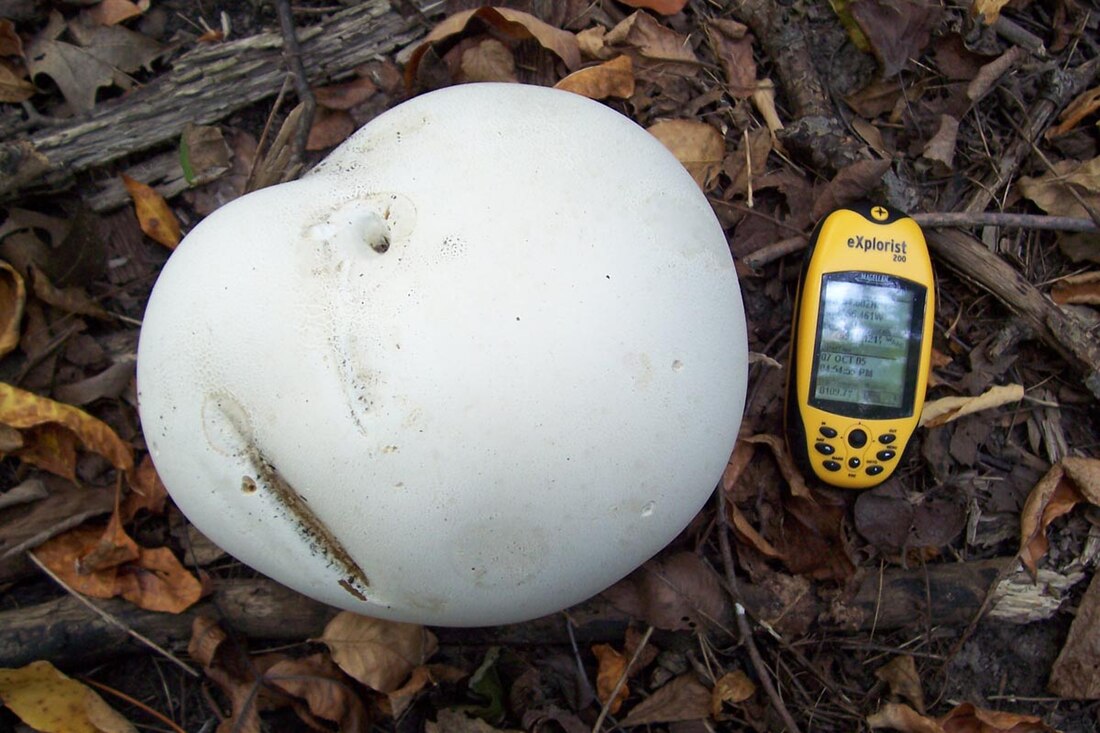Top Qs
Timeline
Chat
Perspective
Calvatia gigantea
Species of mushroom From Wikipedia, the free encyclopedia
Remove ads
Calvatia gigantea, commonly known in English as the giant puffball, is a puffball mushroom found in meadows, fields, and deciduous forests in late summer and autumn. It is found in temperate areas throughout the world.
Remove ads
Taxonomy
The classification of this species has been revised in recent decades. Puffballs, earthballs, earthstars, stinkhorns and several other kinds of fungi were once thought to be related and were known as the gasteromycetes or 'stomach' fungi, because the fertile material develops inside spherical or pear-shaped fruitbodies; however, this group is now known to be polyphyletic.[1][2][3][4]
Today, some authors place the giant puffball and other members of genus Calvatia in order Agaricales. The giant puffball has also been placed in two other genera, Lycoperdon and Langermannia, in years past. The current view is that the giant puffball belongs in Calvatia.[5]
Remove ads
Description
Summarize
Perspective
Calvatia gigantea grows up to 10–50 centimetres (4–19+1⁄2 in) wide and high.[6][7] It can grow to 80 cm diameter and weigh several kilograms.[1] A specimen weighing over 23 kg (51 lb) was recorded in Thunder Bay, Ontario, Canada.[8]
The interior of an immature puffball is white, while that of a mature specimen is greenish brown.[9][10][verification needed] The fruiting body of a puffball mushroom develops within a few weeks and soon begins to decompose and rot, at which point it becomes dangerous to eat. Unlike most mushrooms, all the spores of the giant puffball are created inside the fruiting body; large specimens can easily contain several trillion. The spores are yellowish, smooth, and 3–6 μm in size.[9][10][verification needed] They produce a white spore print when young, while it is olive with an unpleasant smell in age.[7] Prof. John Lindley has calculated that C. gigantea grows at a rate of sixty million new cells per minute[11] on its way to making seven quintillion (7,000,000,000,000,000,000) spores.[12]
Similar species
Giant puffballs resemble the poisonous earthball (Scleroderma citrinum). The latter are distinguished by a much firmer, elastic fruiting body, and having an interior that becomes dark purplish-black with white reticulation early in development.
Identification techniques make it relatively easy to distinguish from others of its genus.[7]
Remove ads
Habitat and distribution
The giant puffball is commonly found in meadows, fields, and deciduous forests in late summer and autumn. It is found in temperate areas throughout the world.[13]
Conservation
It is widespread and common in the United Kingdom[13] and North America (August–October) except for the southeast United States.[7] It is protected in parts of Poland and is of conservation concern in Norway.[13]
Uses
Summarize
Perspective

Culinary
The large white mushrooms are edible when young, as are all true puffballs, but they can cause digestive issues if the spores have begun to form—as indicated by the flesh being yellowish or greenish-brown instead of pure white.[9][10][verification needed] An overripe puffball will fall apart when touched or if cut open, and should be discarded.[14] Some people experience a laxative effect from eating this species.[9]
Immature gilled species still contained within their universal veil can look similar to puffballs. Many such species are poisonous, or even deadly. To distinguish puffballs from such poisonous fungi, they are cut open; edible puffballs have a solid white interior and have "no gills or other imperfections".[15][16]
Medical
Puffballs are a known styptic and have long been used as wound dressing, either in powdered form or as slices 3 cm thick.[17] Authors Hui-Yeng Y. Yap, Mohammad Farhan Ariffeen Rosli, et al. found evidence to suggest that C. gigantea was "traditionally used by American Indians, Nigerian and German folks" for this purpose. The authors, however, did not specify the preferred form of wound dressing (e.g., powdered or sliced). [18]
New Zealand Māori used it to stem bleeding and treat burns, and also a food source.[19]
Remove ads
References
Further reading
External links
Wikiwand - on
Seamless Wikipedia browsing. On steroids.
Remove ads





